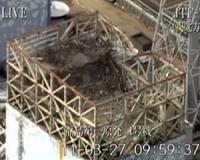| . |  |
. |
Tokyo (AFP) April 17, 2011 The operator of Japan's tsunami-hit nuclear plant said Sunday it aims to reduce radiation leaks within three months and to achieve a "cold shutdown" within six to nine months. Japan's embattled Tokyo Electric Power Company (TEPCO) offered the timeline more than five weeks after a giant quake and tsunami knocked out cooling systems at its six-reactor Fukushima Daiichi atomic power station. The damage sent atomic core temperatures soaring in partial fuel rod meltdowns, in what became the world's worst nuclear crisis in 25 years. It has also left the country facing crippling power shortages. Radiation has leaked into the air, soil and sea from the coastal plant northeast of Tokyo, as emergency crews have doused overheating reactors and fuel rod pools to prevent full meltdowns of volatile fuel rods. TEPCO's chairman Tsunehisa Katsumata said at a press conference that the utility aims to cool reactors and start substantially reducing radiation from the explosion-charred facilities within three months. Within six to nine months, TEPCO said in a statement, it expects to achieve "cold shutdowns" of all the six reactors, a stable condition in which temperatures drop and radiation leaks fall dramatically. "As the short-term targets, we have set two steps," said Katsumata. "Step one is to steadily reduce the amount of radiation. "In step two, we aim to control the release of radioactive substances and greatly control the amount of radiation." "There are various risks ahead," he cautioned. "But we aim to complete step one in about three months and step two in another three to six months." TEPCO also said it would put special covers on the heavily damaged reactor one, three and four outer buildings. The company said that an initial focus would be on preventing new hydrogen explosions in reactors by injecting nitrogen, and on avoiding further releases of radioactive water into the environment. Katsumata also apologised and said he was considering resigning over the crisis, which has sparked anger and criticism over the information TEPCO has provided. Prime Minister Naoto Kan called the plan "a small step forward", Kyodo News reported. Trade and industry minister Banri Kaieda earlier said the roadmap would help move the nuclear crisis from the emergency phase into a stabilisation phase. "The government urges TEPCO to carry out the roadmap steadily or carry it out faster than planned," he said. Kaieda added that in six to nine months the government would review the evacuation area around the plant, having set a 20-kilometre (12-mile) exclusion zone and urged people to also leave from a wider 30-kilometre radius. Japan has raised the level of the crisis from five to the maximum seven on an international scale, the same "major accident" category as the 1986 Chernobyl disaster, although it stressed that far less radiation has been released.
Share This Article With Planet Earth
Related Links Bringing Order To A World Of Disasters A world of storm and tempest When the Earth Quakes
 Fukushima Cold In 9 Months; Robots To Explore Reactors
Fukushima Cold In 9 Months; Robots To Explore ReactorsTokyo (AFP) April 17, 2011 The operator of Japan's stricken nuclear plant said Sunday it will send two remote-controlled robots into a reactor building damaged by a hydrogen explosion to gauge radiation and temperature levels. Emergency workers battling to stabilise the plant after a massive earthquake and tsunami knocked out cooling systems on March 11 have not been able to enter any of the reactor buildings since th ... read more |
|
| The content herein, unless otherwise known to be public domain, are Copyright 1995-2010 - SpaceDaily. AFP and UPI Wire Stories are copyright Agence France-Presse and United Press International. ESA Portal Reports are copyright European Space Agency. All NASA sourced material is public domain. Additional copyrights may apply in whole or part to other bona fide parties. Advertising does not imply endorsement,agreement or approval of any opinions, statements or information provided by SpaceDaily on any Web page published or hosted by SpaceDaily. Privacy Statement |